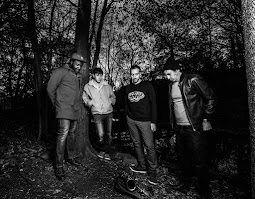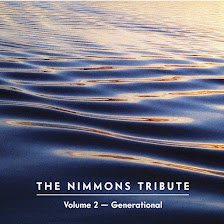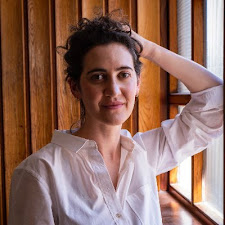I have been impressed with the music and the saxophone playing of Alex LoRe since 2014 when his debut album, "Dream House", was issued on Greg Osby's Inner Circle Music label. When Allen Mednard replaced Colin Stranahan at the drum set for 2019's "Karol" (issued on Challenge Records), the quartet (also featuring pianist Glenn Zaleski and bassist Desmond White) became known as Alex LoRe & Weirdear. The alto saxophonist and composer, originally from Tarpon Springs, Florida, graduated from the New England Conservatory and earned a Master's Degree from the Manhattan School of Music. Currently, he's a member of pianist Maria Sanchez's Quintet and has played with Lucas Pino's No Net Nonet. LoRe has also authored two instruction books, the latest being "The Goldberg Variations for Saxophone Duets, Trios, & Quartets". During the Pandemic, he upload numerous videos of how he was working on playing JS Bach that are fascinating to watch and listen to.
Creative music should challenge us, make us think and move us forward. Music can make one's life better and fuller, one of life's greatest pleasures.
Friday, June 30, 2023
Moving With the Times
Monday, June 26, 2023
Large Ensemble: Roots Music
 |
| Photo: Robert Iannone |
Ben Kono- Oboe, Soprano Saxophone, Flute, Clarinet
Ben Henriques – Alto Saxophone, Soprano Saxophone, Clarinet
Noah Preminger- Tenor Saxophone
Tom Keenlyside- Flute, Alto Flute, Piccolo, Tenor Saxophone
Scott Robinson- Baritone Saxophone, Bass Clarinet, Flute
Michael Kim- Trumpet and Flugelhorn
Brad Turner- Trumpet and Flugelhorn
Derry Byrne- Trumpet and Flugelhorn
Jocelyn Waugh- Trumpet and Flugelhorn
Jeremy Berkman- Trombone
Jim Hopson- Trombone, Euphonium
Andrew Porrier- Trombone
Sharman King- Bass Trombone
Kurt Rosenwinkel- Guitar
Frank Carlberg- Piano
Kim Cass- Bass
Dan Weiss- Drums
Friday, June 23, 2023
The Sounds of 8 Hands Playing
Although best known for his work in saxophonist Noah Preminger's Quartet, guitarist and composer Max Light is just now climbing into the spotlight. His debut album, "Herplusme" (Red Piano Records), was a trio date recorded in 2018 but not issued until February 2020, just a month before the COVID-19 Pandemic shut the door on touring musicians (and the rest of us). He'd already recorded two live albums with trumpeter Jason Palmer, two studio albums with Preminger's ensemble, and albums with Yong Lee, Kevin Sun, Chris McCarthy, and others. Last year, SteepleChase Records released "Songs We Love", a collection of 14 tunes (mostly standards old and new) performed by Preminger and Light––it's well worth seeking out for the delightful conversations the two musicians over the course of 65 minutes. When producer and label owner Nils Winther offered Light the opportunity to record his second album as a leader, it was obvious from the get-go the guitarist would reach out to Preminger.
Take a listen to the title track:
Thursday, June 22, 2023
Large Ensemble Music: Oh, Canadian
Composer, arranger, and trombonist is the brainchild behind the Composers Collective Big Band, a 19-member ensemble based in Toronto, Ontario, Canada. In existence since 2005, the CCBB was created to shine a spotlight on Canadian composers through commissions and concerts. Those performances also serve to highlight the variety of great musicians that work and teach in the Province. Surprisingly, the ensemble's only recording is a four-track release from 2017.
 |
| Photo: Daniel Cybulskie |
Woodwinds: Tara Davidson (as, ss, fl), Chris Roberts (as, cl, fl), Paul Metcalfe (ts, cl, fl), Jared Welsh (ts, cl, fl), Marcus Ali (bs, bc, fl)
Trumpet & Flugelhorn: Jason Logue (lead), John Pittman, Brian O’Kane, John MacLeod
Trombone: William Carn, Tom Richards, Pat Blanchard, Karl Silveira, Sylvain Bedard (bass tbn)
Electric Guitar: Erik Patterson
Piano & Keyboard: Carissa Neufeld
Acoustic & Electric Bass: Justin Gray
Drums: Jeff Halischuk
Featuring Special Guests: Pablosky Rosales (Tres), Les Alt (Flute), Amely Zhou (Erhu), Maya Killtron (voice), Jonathan Kay (Tenor Sax), Andrew Kay (Alto Sax), Ravi Naimpally (Tabla)
Tara Davidson - alto saxophone, soprano saxophone, clarinet
Mike Murley - tenor saxophone
William Carn - trombone
Alex Dean - baritone saxophone, bass clarinet
Sean Nimmons - piano, Fender Rhodes
Jon Maharaj - bass
Ethan Ardelli - drums
Heather Bambrick - vocals on one track
Monday, June 19, 2023
Juneteenth Music
This, from Bandcamp.com:
On June 19 (from midnight (PT) June 19 to midnight (PT) June 20), we’ll hold our annual Juneteenth fundraiser, where we donate 100% of our share of sales* to the NAACP Legal Defense Fund to support their ongoing efforts to promote racial justice through litigation, advocacy, and public education.
This annual fundraiser is part of our larger, ongoing commitment to racial equity, and we’ll continue to promote diversity and opportunity through our mission to support artists, the products we develop, those we promote through the Bandcamp Daily and Bandcamp Radio, how we work together as a team, who and how we hire, and our relationships with organizations local to our Oakland space (some of which we’ve highlighted below).
We hope you’ll help us spread the word about the upcoming fundraiser, and thank you for being a part of the Bandcamp community!
Ethan Diamond
CEO & Co-Founder of Bandcamp
Here's a few suggestions:
Saturday, June 17, 2023
Ms.Oh and the Future
 |
| Photo: Shervin Lainez |
 |
| Photo: Shervin Lainez |
"The Glass Hours" closes with "Hatchling" (which one imagines is dedicated to her son)––Ms. Oh is on electric bass again so it's the sax, voice, and piano that present the melody then break it into melodic fragments. The piece moves into a long rubato section before the piano and voice build off the bounce of the bass and drums to playfully strut and dance to the close!
Here's the opening track, "Circles":
Monday, June 12, 2023
Large Ensembles & Real Life, Pt 2: Learning about & From the Past
When one thinks of the early years of Jazz, we think of New Orleans (before the brothels were closed), Chicago (especially after Prohibition was announced), and New York City (where many of the major record labels were located). However, a case can be made (and has been–see below) for Richmond, Indiana, especially after the establishment of Gennett Records. The brainchild of three sons of an Italian immigrant family, Gennett managed to record King Oliver and Louis Armstrong, Jelly Roll Morton, Bix Beiderbecke, and Hoagy Carmichael all before the end of the 1920s. Recording conditions were not the best (the studio was located near a very busy railroad bridge) but much of the music was stellar.
 |
| Photo: Greg Reynolds |
Thursday, June 8, 2023
Hard & Heart to Know Where
 |
| Photo: Matt Griffiths |
Tuesday, June 6, 2023
Henry Threadgill, Book & Music – "You're Going to Have to Serve Your Time"
If memory serves correctly, I first encountered the music of Henry Threadgill in Cutler's Record Shop in New Haven, CT, on seeing the first Air Lp, "Air Song" (Why Not Records imported from Japan), on the Jazz "New Releases" section of the wall. Intrigued, I discovered that the trio (saxophonist, flutist, and composer Threadgill, bassist Fred Hopkins, and drummer Steve McCall) hailed from Chicago and were members of the Association for the Advancement of Creative Musicians (AACM). By this time, I had heard the Art Ensemble of Chicago, Anthony Braxton, and Muhal Richard Abrams, fascinated as well as puzzled by this music that often eschewed typical jazz forms to look for new sounds and mixtures.
 |
| Photo: John Rogers |
 |
| Photo: Jeenah Moon/NYTimes |
Alfredo Colón – alto saxophone
Noah Becker – alto saxophone, clarinet
Peyton Pleninger – tenor saxophone
Craig Weinrib – percussion, electronics
Sara Caswell – violin
Stephanie Griffin – viola
Mariel Roberts – cello
Christopher Hoffman – cello
Jose Davila – tuba
David Virelles – piano
Sara Schoenbeck – bassoon
Adam Cordero – bassoon







.jpg)







.png)















